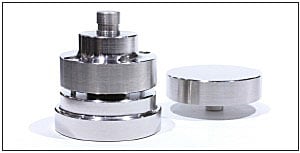Spherically Seated Compression Plates

Features:
- Self-alignment of the upper spherically seated plate
- Ideal for compression testing non-parallel specimens such as finished products
- Available with 100 mm (3.9 in), 210 mm (8.3 in), and 310 mm (12.2 in) diameters
- Maximum capacity of 250 kN (55,000 lbf)
- Hardened faces preserve surface smoothness
Relevant Materials:
Plastics, Metals, Rubber, Lumber, Cement
Relevant Specimens:
Cylinders, Cubes, Cuboids
The advantage of this type of compression plate set, which is comprised of a spherically seated upper compression plate and a fixed lower compression plate, is the ability of the upper spherically seated plate to self-align when contacting the specimen surface. This enables the application of a uniform load to non-parallel specimens such as finished products.
Spherically seated compression plate sets are available with diameters of 100 mm (3.9 in), 210 mm (8.3 in), and 310 mm (12.2 in). The surface hardness of both the upper and lower compression plate is 60 on the Rockwell HRC scale.
The upper plate attaches to a compression and bending loading jig and the bottom plate fits onto the table of the universal tester.
Spherically seated compression plates, which include a compression and bending loading jig in addition to the upper and lower plate set, are also available as kits in some regions. Please contact your local Shimadzu representative for details.
News / Events
-
AUTOGRAGH AGS-X2 Series has been released
The Shimadzu AUTOGRAPH AGS-X2 series provides superior performance and practical testing solutions for a wide array of applications. Offering high-level control and intuitive operation, the AGS-X2 series sets a new standard for strength evaluations while providing the utmost in safety considerations in a modern, stylish design.
-
AUTOGRAGH AGS-V Series has been released
Shimadzu Corporation released the Autograph AGS-V Series precision universal testing machine. In this series, the range over which the force measurement accuracy is guaranteed has been increased by a factor of two compared with existing machines. As a result of this new function, the work required to change force measurement sensors and accessories required for measurement can be reduced.
-
High-Speed Video Camera HyperVision HPV-X3 has been released
Recording speed of 20 million frames/second, the highest in its class provides larger, clearer, high-sensitivity recording. HPV-X3 is equipped with a synchronized recording function and high-level analytical capabilities that accommodate a variety of software programs.
-
New Video: AUTOGRAPH AGX-V2 Voice Operation Device XV-Talk
We will introduce how XV-Talk, the world's first voice control device installed in Shimadzu's latest tensile tester AGX-V2, can be used in various scenarios.
-
New Video: AUTOGRAPH AGX-V2 Operation Control Panel Stand-alone test feature
We will introduce a new feature of Shimadzu's latest tensile tester, AGX-V2, a stand-alone testing function using a large color LCD touch panel.
-
New Autograph AGX-V2 Series Precision Universal Testing Machines
The World’s First Testing Machines Equipped with a Voice Operation Device


